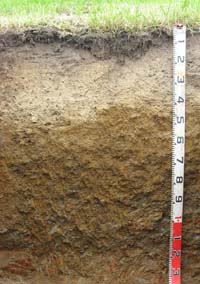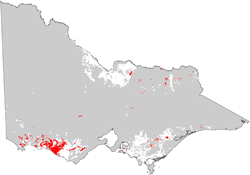Victorian Dairy Soils - Chromosols
Back to: Victorian Dairy Soil
| Chromosols (Australian Soil Classification) are soils that have strong texture contrast between the surface (A) horizons and the clay subsoil (B) horizons. The subsoil is also not strongly acid, i.e. pH is greater than 5.4 in water, and non-sodic (at least in the upper horizons). Chromosol subsoils are usually better structured and less dense than Sodosols. |  Brown Chromosol near Jancourt in south west Victoria |
| Chromosols are common in a range of landscapes throughout south-west Victoria, particularly in the Glenelg-Hopkins catchment management region. Soil pit site SW11 is an example of a Brown Chromosol near Condah. Chromosols are most common on sedimentary plains and rises in southern parts of the Corangamite region e.g. south-east and south-west of Colac. Chromosols also occur in some areas on basalt and volcanic ash/scoria deposits, where they often have dark coloured (dark grey to black) subsoils. Soil pit site SW35 is an example of a Black Chromosol near Larpent. |  |
Chromosols are not widespread in the agricultural areas of West Gippsland. They are most common in the western part of that region and are often associated with Sodosols, e.g. in the Macalister Irrigation District. Soil pit site GP65 is an example of a Brown Chromosol near Nambrok. Chromosols are not common in northern Victorian dairy regions, but can be associated with Sodosols. Soil pit site GN28 is an example of a Brown Chromosol at Tatura. Soil pit site GN28 is an example of a Brown Chromosol at Tatura.
In north-east Victoria, Red Chromosols are common on hills in areas such as the Kiewa and Tallangatta River Valleys. Soil pit site NE24 is an example of a red Chromosol in the Tallangatta Valley.
Management Considerations
Texture contrast soils usually have restricted root and water movement into the clay rich subsoils. However, Chromosols are non-sodic, at least in the upper subsoil, and tend to be better structured and drained than Sodosols. Well structured subsoils, especially those with finer polyhedral to blocky structure, will provide fewer restrictions to plant root growth and result in greater plant available water capacity.


